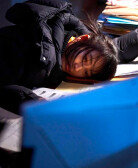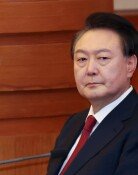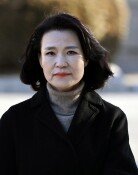Police Enter Ssangyong Motor Plant
Ssangyong Motor unionists and police yesterday continued fighting at the carmakers plant in Pyeongtaek, Gyeonggi Province. Workers attacked police with slingshots and Molotov cocktails while police officers circled above the plant to fire tear gas.
Police went further into the plant, moving 100 meters forward from the front and southern gates and 300 meters forward from the northern gate.
When police approached the painting plant and ordered unionized workers to disperse via speakers at 6:15 a.m., masked unionists appeared at the entrance. Shortly afterwards, around three or four workers threw Molotov cocktails at piles of tires.
Thick smoke then rolled up and gas bottles hidden in the tire piles exploded. At the same time, unionists fired nuts and bolts with slingshots from the top of the plant.
Police concluded that it would be hard to go closer to the plant, so they dispatched a helicopter that fired tear gas over the roof of the painting plant around 11 a.m. At 4 p.m., three police helicopters were used to fire tear gas and were shot at by unionized workers with nuts and bolts.
In addition to about 1,000 riot police stationed inside the Pyeongtaek plant, police dispatched around 2,000 guards and special attack troops nearby.
The windows of the Ssangyong administrative building facing the painting plant were all broken. Nuts and bolts shot by large-scale slingshots flew over the building to reach the front yard, hitting two staff in the head and arms. Three police officers were taken to hospitals also after being hit.
The companys 1,500 employees arrived around 8 a.m., continuing to undergo inspection of the main administrative building, research and TRE facilities, and storage space for two straight days.
The Korea Confederation of Trade Unions held a news conference in front of the Korea Development Bank in central Seoul yesterday, saying, From Wednesday, well censure the government for exercising public power. Well also stage a general strike to prevent the National Assembly from revising controversial bills such as those on non-regular workers and media reform.







